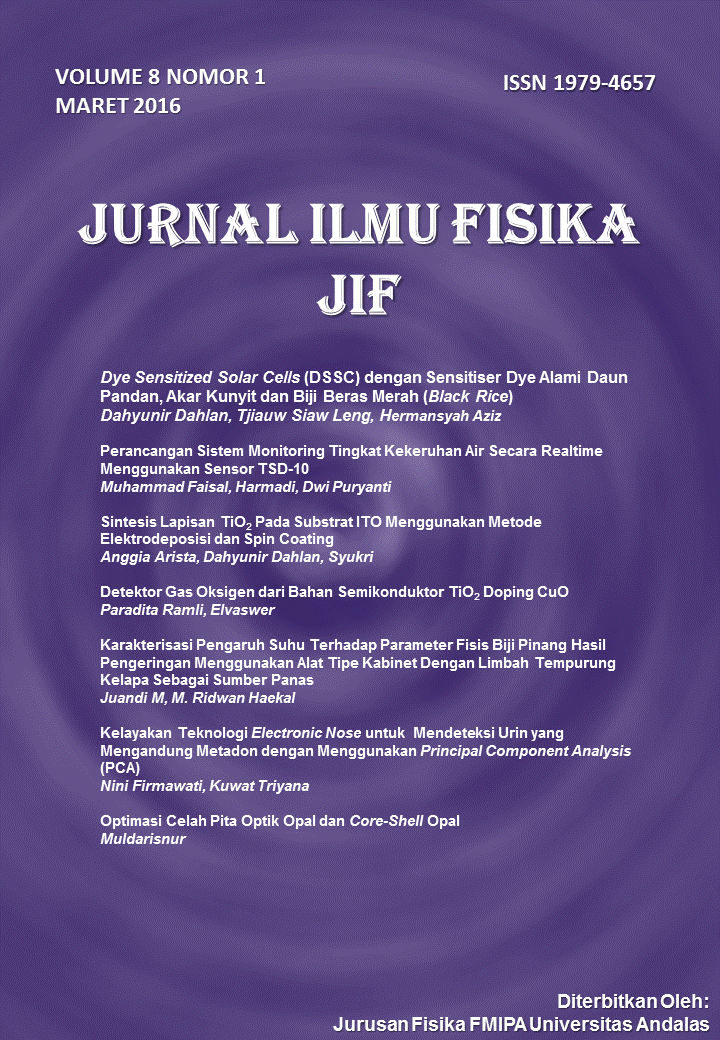Sintesis Lapisan TiO2 Pada Substrat ITO Menggunakan Metode Elektrodeposisi dan Spin Coating
DOI:
https://doi.org/10.25077/jif.8.1.17-27.2016Abstract
Telah dilakukan sintesis lapisan tipis TiO2 menggunakan metode elektrodeposisi dan spin coating. Elektrodeposisi menggunakan larutan elektrolit 0,25 M TiCl3. Dalam penelitian ini juga dilakukan variasi larutan elektrolit dengan penambahan CTAB, PEG dan penambahan H3BO3. Selanjutnya lapisan TiO2 disintesis menggunakan metode spin coating yang dilakukan di atas lapisan TiO2 setelah elektrodeposisi. Larutan prekusor yang digunakan adalah Titanium Butoxide (Ti(OC4H9)4 dengan waktu aging larutan 48 jam. Hasil karakterisasi SEM menunjukkan elektrodeposisi lapisan tipis TiO2 dengan penambahan CTAB dan PEG menghasilkan morfologi permukaan yang homogen dan berpori pada lapisan TiO2. Berdasarkan hasil karakterisasi UV-Vis, energi gap TiO2 pada sampel yang disintesis menggunakan metode elektrodeposisi adalah 3,86 eV, sedangkan nilai energi gap yang didapat pada sampel menggunakan metode spin coating adalah 3,18 eV.
Downloads
References
Atmono,T., Yunanto, 2001, Pembuatan dan Karakterisasi Multilayer SiO2/TiO2, Prosiding Pertemuan dan Presentasi Ilmiah Penelitian Dasar Ilmu Pengetahuan dan Teknologi Nuklir P3TM-BATAN, Yogyakarta.
Ceotto, E.F., Souza,B., Teschke, 2000, Ionic Surfactant Films Imaed by Atomic Force Microscopy, Departamento de Fisica, Universidade Federal de Vicosa, 36571-000 Vicosa, MG, Brazil.
Grätzel, M., 2003, Review Dye-Sensitized Solar Cells, Journal of Photochemistry and Photobiology C: Photochemistry Reviews, Volume 4, hal 145-153. DOI: https://doi.org/10.1016/S1389-5567(03)00026-1
Hikam, M., 2002, Studi Kekristalan PbZrx Til-xO3 yang Disiapkan Dengan Pelapisan Putar (Spin Coating), Jurnal Sains Materi Indonesia, ISSN 1411-1098.
Jitputti, J. Pavasupree S., Suzuki Y., dan Yoshikawa S., 2008, Synthesis of TiO2 Nanotube and Its Photocatalytic Activity For H2 Evolution, Japanese Journal of Applied Physics, Volume 47, Number 1, hal 751-756. DOI: https://doi.org/10.1143/JJAP.47.751
Karuppuchamy, S., Andou, Y.,dan Endo, T., 2012, Synthesis of Nanostuctured TiO2 Photoelectrode for Flexible Dye Sensitized Solar Cell Application, Apply Nanosci, DOI 10.1007/s13204-012-0140-6. DOI: https://doi.org/10.1007/s13204-012-0140-6
Kong F.T., Dai S.Y., dan Wang K.J., 2007, Review of Recent Progress in Dye-Sensitized Solar Cell, Hindawi Publishing Corporation Advances in Optoelectronics, Article ID 75384. DOI: https://doi.org/10.1155/2007/75384
Nadeak, S.M.R. dan Susanti, D., 2012, Variasi Temperatur dan Waktu Tahan Kalsinasi Terhadap Unjuk Kerja Semikonduktor TiO2 sebagai Dye Sensitized solar cell (DSSC) dengan Dye dari Ekstrak Buah Naga Merah, Jurnal Teknik ITS, Vol. 1, ISSN 2301-9271.
Nugroho, A., dan Noviarti, 2011, Analisis Radionuklida 235 U Dalam Pelat Elemen Bakar (Peb) U3si2-Al Densitas 2,96 G/Cm3 Pasca Iradiasi, ISSN 0216-3128.
Nurmawarti, I., Abdullah, M., 2009, Distribusi Celah Pita Energi Titania Kotor, Jurnal Nanosains dan Nanoteknologi, ISSN 1979-0880, hal 38-42.
Perdana, Ramadhani., 2014, Pengaruh Suhu Pemanasan dan Waktu Aging Terhadap Sifat Fisis TiO2 yang Disintering Menggunakan Metode Sol Gel Spin Coating, Tesis, FMIP UNAND, Padang. DOI: https://doi.org/10.25077/jif.6.1.18-24.2014
Putama, I.L.M., 2014, Sintesis Lapisan Tipis TiO2 Dengan Metode Elektrodeposisi Menggunakan Variasi Arus Kontinu dan Arus Pulsa, Tesis, FMIPA UNAND, Padang.
Sotter, E., X. Vilanova, E. Liobet, M. Stankova. Correig., 2005, Niobium Doped Titanium Nano powder for gas sensor Applications, Journal of Optoelectronics and Advanced Material Vol. 7. No. 3. PP. 1395-1398.
Downloads
Published
How to Cite
Issue
Section
Citation Check
License
Please find the rights and licenses in JIF (Jurnal Ilmu Fisika).
1. License
The non-commercial use of the article will be governed by the Creative Commons Attribution license as currently displayed on Creative Commons Attribution-NonCommercial 4.0 International License.
2. Author's Warranties
The author warrants that the article is original, written by stated author(s), has not been published before, contains no unlawful statements, does not infringe the rights of others, is subject to copyright that is vested exclusively in the author and free of any third party rights, and that any necessary written permissions to quote from other sources have been obtained by the author(s).
3. User Rights
JIF's spirit is to disseminate articles published are as free as possible. Under the Creative Commons license, JIF permits users to copy, distribute, display, and perform the work for non-commercial purposes only. Users will also need to attribute authors and JIF on distributing works in the journal.
4. Rights of Authors
Authors retain the following rights:
- Copyright, and other proprietary rights relating to the article, such as patent rights,
- The right to use the substance of the article in future own works, including lectures and books,
- The right to reproduce the article for own purposes, provided the copies are not offered for sale,
- The right to self-archive the article.
5. Co-Authorship
If the article was jointly prepared by other authors, the signatory of this form warrants that he/she has been authorized by all co-authors to sign this agreement on their behalf, and agrees to inform his/her co-authors of the terms of this agreement.
6. Termination
This agreement can be terminated by the author or JIF upon two months's notice where the other party has materially breached this agreement and failed to remedy such breach within a month of being given the terminating party's notice requesting such breach to be remedied. No breach or violation of this agreement will cause this agreement or any license granted in it to terminate automatically or affect the definition of JIF.
7. Royalties
This agreement entitles the author to no royalties or other fees. To such extent as legally permissible, the author waives his or her right to collect royalties relative to the article in respect of any use of the article by JIF or its sublicensee.
8. Miscellaneous
JIF will publish the article (or have it published) in the journal if the article's editorial process is successfully completed and JIF or its sublicensee has become obligated to have the article published. JIF may conform the article to a style of punctuation, spelling, capitalization, referencing and usage that it deems appropriate. The author acknowledges that the article may be published so that it will be publicly accessible and such access will be free of charge for the readers.



